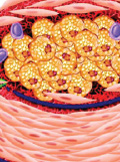The eLitMed.hu medical portal uses computer cookies for convenient operation. Detailed information can be found in the Cookie-policy.
LAM Extra for General Practicioners - 2013;5(04)
Content
[VITAMIN D TREATMENT: HORMONE THERAPY FOR PATIENTS WHO NEED IT OR SIMPLY A SUPPLEMENTATION FOR EVERYONE?]
[Various medical associations issue different recommendations for the prevention and treatment of vitamin D deficiency. These significant differences are partly explained by the different definition of normal vitamin D level and the use of completely different mathematical models to predict the increase in vitamin D level as a response to therapy. According to the Institute of Medicine (IOM), the target vitamin D level is 20 ng/ml, whereas the Endocrine Society (ES) recommends 30 ng/m as the miminum target value. According to the ES, a 1 ng/ml increase of vitamin D level can be reached by a daily intake of 100 NE, while the IOM recommends 3.6 ng/ml. Moreover, the IOM states that the effect of therapy on serum level is nonlinear. These differences show that the ES and IOM have different views on the risk of adverse effects. The IOM recommends 400 IU vitamin D daily for children younger than 1 year, 800 IU for those above 70 years and 600 IU/per day for everyone else. The ES recommend 400-1000 IU daily for all infants and 1500- 2000 IU for adults. Screening, however, is not recommended by either society. To decrease uncertainty concerning the side effects of higher-dose vitamin D treatment, it is important to understand, use and support the function of the pharmacovigilance system of the pharmaceutical industry that manufactures and markets various (prescription, over-the-counter) preparations. This is what the author aims to highlight in the second part of this article. Using this system, both the doctor and the patient can help support and accept the justification of higher-dose vitamin D therapy.]
[NEW POTENTIAL PERSPECTIVES OF STATIN THERAPY]
[Statins have become crucial components of the therapy of cardiovascular diseases. Beyond their cholesterol-lowering effect, statins turned out to have further beneficial effects on various vascular mechanisms. One of the best known effects is antithrombotic capacity, which is related partly to platelet function and partly to the coagulation cascade. Besides experimental observations, interventional clinical trials have also demonstrated that statins have an antithrombotic effect both in arterial and venous thrombosis. Regarding the effects of statins on dementia, previous studies with relatively small sample sizes had controversial results. Recently, two observational studies of tens of thousands of elderly patients reported that statins reduce the incidence of nonvascular dementia. Evaluation of the data revealed that statins have pleiotropic effects in this case, too. The results discussed here shed light on new benefits of statin therapy used for reducing cardiovascular mortality, namely the prevention of thrombotic events and dementia. These benefits are related to the antithrombotic and anti-inflammatoric capacity of statins.]
1.
Clinical Neuroscience
[Headache registry in Szeged: Experiences regarding to migraine patients]2.
Clinical Neuroscience
[The new target population of stroke awareness campaign: Kindergarten students ]3.
Clinical Neuroscience
Is there any difference in mortality rates of atrial fibrillation detected before or after ischemic stroke?4.
Clinical Neuroscience
Factors influencing the level of stigma in Parkinson’s disease in western Turkey5.
Clinical Neuroscience
[The effects of demographic and clinical factors on the severity of poststroke aphasia]1.
2.
3.
4.
5.




